The Streets Of Caracas - Part 3
Here are more action photos from the street, with the Venezuelan opposition demonstrating their credentials to take charge of the emergent democratic government (see also Part 1 and Part 2).
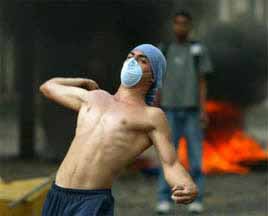
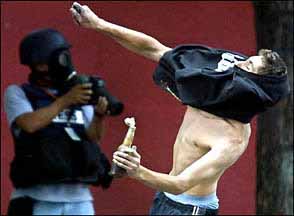
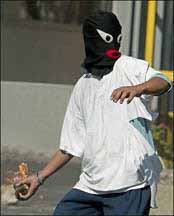
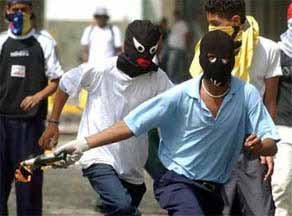
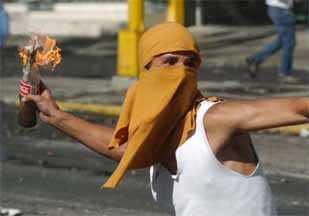
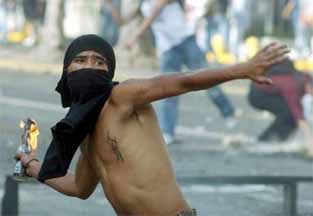
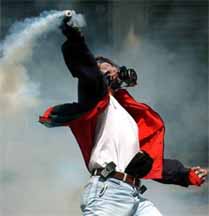
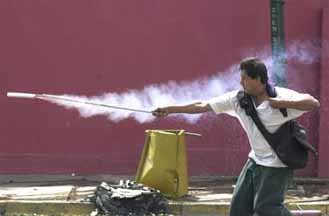
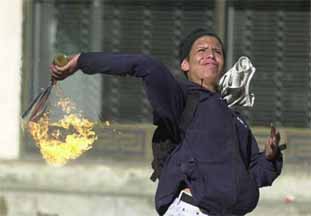
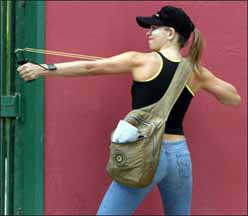
These photos can be seen by everyone, but the opposition media and leaders do not condemn these types of actions. It should be noted that if this had occurred in the United States, national guard tanks would have rolled in with firm orders to shoot on sight. Instead, the big debate today was whether street violence was only occurring in upper/midlle class areas or in lower-class barrios.
On one side, Venezuelanalysis.com reports:
Throughout the day on Saturday, Sunday, and Monday, small groups of opposition protesters took to the streets and erected barricades to block traffic in several different middle class and upper middle class neighborhoods in Caracas. Local police officials kept away from the protests while National Guard troops attempted to clear the streets for through traffic.
The result were numerous confrontations between national guard and protestors, in which protestors attacked with rocks, Molotov cocktails, home made rockets, and in some cases even with gunfire. The National Guard responded with large amounts of tear gas and shotgun fire with plastic shrapnel. Numerous individuals were wounded, including protestors, guard troops, and some journalists.
Two young boys who were caught by Military Police officers near Altamira Monday afternoon, confessed on TV having received money from a man from the opposition Primero Justicia (Justice First) party, to transport some tires and gas from a nearby building, and then burn them in the middle of a street. “I did it because I needed the money for my family,” said one of the boys who appeared to be very poor. Both youngsters said they regretted having done what they did.
In sharp contrast with the destruction and chaos generated by opponents of President Chavez in middle and upper-class sections of the city, in working-class areas the situation is completely normal.
At Caricuao, a working-class neighborhood in southwestern Caracas, a small group of individuals allegedly not from the area, tried to set up roadblocks as oppositionist Metropolitan Police officers watched. The protest was presented by commercial anti-Chavez TV network Globovision as proof of a working-class neighborhood protesting against the President. Minutes later, hundreds of neighbors appeared at the scene and drove away the small group of demonstrators. The streets were later cleaned by the neighbors themselves.
A similar situation occurred in El Valle, another working-class neighborhood in southwester Caracas, where hundreds of Chavez supporters drove away a small group of protestors who pretended to set up roadblocks.
(Venezuelanalysis.com) The Dark Side of Venezuela’s Opposition. By Carmen Elena Balbás Rivas. July 8, 2004.
In the political conflict that the country is suffering, the issue of democracy arises from an extreme condition: that of democracy’s survival. For some people, democracy refers to the one that has just been obtained, whereas for others it refers to the one that is at risk of being lost.
During the five days that “shook” the eastern sector of Greater Caracas, Plan “Guarimba”[1]—active non-violent protest—attempted to emulate the demonstrations of young, middle class North American university students of the 50’s. These were modeled on the non-violent terms set by Gandhi when he confronted the enormous British power in India. Any possible likeness to the Guarimba ends there. In contrast to the Indian movement that had withstood half a century of oppression, the Guarimba plan died abruptly, due to the violence with which it started and ended. Its outcomes were exactly as planned and as expected[2] and the actual violence carried out—not the supposed, declared, non-violence– ended up falling back, once again, upon the perpetrators.
The mini-demonstrations were intended to create a climate of un-governability, of repression, of the violation of human rights and to spur foreign military intervention. The high-class urban rioters, promoted the menace of crisis in the capital and the common focus was to hurt the community.[3]
During the first three years, political violence has settled into the lives of Venezuelans because we have all been subject and object of its diverse forms: the unthinkable – the coup d’etat of April 11th; the unexpected – the pot-banging demonstrations; the completely new – the oil industry sabotage and the Guarimba. Worse still, the recurrence of political violence has become an undeniable part of our everyday life, sowing disappointment, rejection, and defenselessness in the ordinary citizen.
What sin have we committed to deserve this fate? The actors and executors of this state of affairs use old words as if they were new to justify it, word such as: “regime,” “terrorism,” “repression,” “dictatorship,” “authoritarianism.” Or, they allow the timid entrance into their vocabulary of terms with new meaning such as: “reconciliation,” “democratization,” and “tolerance.” These words rapidly become stereotyped and fossilized in the Gorgon mirror of the media. It appears that coexistence and complaint are only a matter of words. Making it all the more necessary to find the right and necessary words capable of calming and healing the anxiety of citizens.
In Homer’s epics, therapeutic words are used in three ways: imperative—as a plea; magic—as a spell; and psychological or natural—as pleasure. In the political language that surrounds us, there is no time for pausing and thinking deeply, let alone time for consent and enjoyment–which does not mean complacency. There is an absence of words that would heal the broken bridges of communication. In its stead, there are only words that irritate, punish, and divide. The political discourse has another singular characteristic: it is a monologue. Rather than speaking, it actually mutes. There is no exchange of reasons, which always perfects debate, only the announcements of principles, with no comparisons, which mutilates words.
In this war of symbols, an authoritarian culture is enthroned that values dissidence and conflict. It prefers forceful means to deal with these and assumes that force is “natural” or preferable for establishing an “order” favored by those who say they walk on the democratic path.
In a crisis situation, an authoritarian culture speaks a language that seems attractive to many. Starting from the appropriation of social fears, it elaborates on these, such as “foreign intervention” or “Castro-communism.” It demands the need to impose a democratic order, that is, their version of order, through illegal and forceful means. It uses fear, threats, and blackmail, linked to an uncertain future, and turns them into concrete fears that end up being instruments of social control, such as fear of dictatorship, communism, or civil war. Trying to impose order through violence, allows them to divide and control.
The so-called civil society legitimizes authoritarian tendencies in our society when it justifies violent actions and prefers force as a method of social order. It confuses social spaces and limits such as the occupation of Plaza Altamira. That incident was the forceful appropriation of a public space, making it private and dividing the city into East and West. Thus, they ignore that streets and plazas have no borders because public areas do not need these, only that which is private needs limits and borders.
The authoritarian discourse proposes the use of force to close streets, burn tires, destroy property, and build barricades and to retreat into the private sphere. All this reinforces the atomization of social life and impedes the building of community alternatives. It violates the right to public meetings and creates urban ghettos as a political recourse. The other becomes the enemy in this authoritarian urban guerrilla, which nonetheless claims to be a “salvation.”
Social ghettos rupture common solidarity. They and are based on cultural, social, political and economic segregation and, in the long term, have a dehumanizing effect.
The media also have a role to play in making domination subjectively viable in the social conscience, which is contrary to the development of democracy. Political problems are presented in terms of “struggle,” “parts in a war”, “combat,” “coup,” “confrontation.” Solutions are seen as a “defeat” of those one opposes. The language used in politics and in the media propose to “liberate Venezuelan society,” transposing military logic to the civil sphere. It converts the Armed Forces into either the “repressive enemy” of sectors who see themselves as victims or as the “executing arm” that “liberates the people from tyranny”.
Journalists turn events upside down, giving them characteristics that they inherently lack. They redefine reality through images, headlines, and hyperbolic statements. Thereby, only one reality is presented and authoritarian culture is reinforced. Only one definition, interpretation, and experience of reality is permitted. Plurality, discussion, and collective negotiation of consensus are blocked. Meanwhile, order is defined in terms of domination and submission through accusations without any corroboration; accusations of corruption, denigrating institutions and people, calling for civil disobedience–read military coup d’états.
Each type of media bases itself in an authoritarian language that organizes its form and content as “valid interpretations” of reality, while marginalizing or excluding alternative interpretations. There is a system to what is presented or not in the media, which corresponds to opposition interests. They create a system of meaning based on only one vision of the world—their world—above all others, centered upon certain themes that are seen as valid and viable for their own political purposes. The media, for example, at Fuerte Mara, silencing events at the Universidad Simon Bolivar, and the violation of human rights in Iraq, did not cover certain events that took place. Journalists project visions symbolically, as propaganda for certain ideas that will affect the public that sees them.
The spiral of silence–of those who consider themselves a minority—is echoed in the media who believe they are heirs of progress, democracy, justice, and social equality. They dust off sacred slogans, untouchable declarations, and immovable demands to defend sacred institutions that are incomprehensively threatened. But, above all, they represent the dramatic resurrection of the ancient Templars, called to a holy crusade to rescue the country from barbarianism, anti-civilization, and violence. Hail Democracy, those who are about to kill you, salute you.
[1] A concerted opposition plan for blocking roads and highways by burning tires, which ultimately resulted in violence and deaths. It took place in February 27, 28, 29 and March 1, 2, 2004.
[2] Expansion to the western sector of Caracas, to other cities and international attention
[3] Ex-president Carlos Andrés Pérez in a broadcast on Radio Caracol threatened, “There are going to be many deaths in our country”. (Diario Vea, Friday, May7, 2004, page 3)